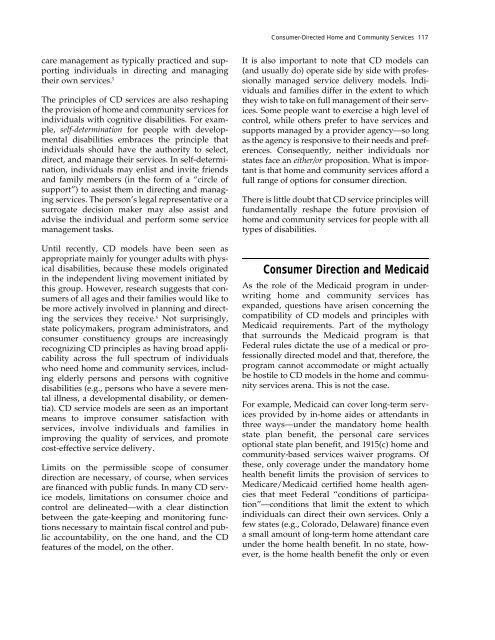Full PDF Version - ASPE - U.S. Department of Health and Human ...
Full PDF Version - ASPE - U.S. Department of Health and Human ...
Full PDF Version - ASPE - U.S. Department of Health and Human ...
- No tags were found...
Create successful ePaper yourself
Turn your PDF publications into a flip-book with our unique Google optimized e-Paper software.
Consumer-Directed Home <strong>and</strong> Community Services 117care management as typically practiced <strong>and</strong> supportingindividuals in directing <strong>and</strong> managingtheir own services. 5The principles <strong>of</strong> CD services are also reshapingthe provision <strong>of</strong> home <strong>and</strong> community services forindividuals with cognitive disabilities. For example,self-determination for people with developmentaldisabilities embraces the principle thatindividuals should have the authority to select,direct, <strong>and</strong> manage their services. In self-determination,individuals may enlist <strong>and</strong> invite friends<strong>and</strong> family members (in the form <strong>of</strong> a “circle <strong>of</strong>support”) to assist them in directing <strong>and</strong> managingservices. The person’s legal representative or asurrogate decision maker may also assist <strong>and</strong>advise the individual <strong>and</strong> perform some servicemanagement tasks.Until recently, CD models have been seen asappropriate mainly for younger adults with physicaldisabilities, because these models originatedin the independent living movement initiated bythis group. However, research suggests that consumers<strong>of</strong> all ages <strong>and</strong> their families would like tobe more actively involved in planning <strong>and</strong> directingthe services they receive. 6 Not surprisingly,state policymakers, program administrators, <strong>and</strong>consumer constituency groups are increasinglyrecognizing CD principles as having broad applicabilityacross the full spectrum <strong>of</strong> individualswho need home <strong>and</strong> community services, includingelderly persons <strong>and</strong> persons with cognitivedisabilities (e.g., persons who have a severe mentalillness, a developmental disability, or dementia).CD service models are seen as an importantmeans to improve consumer satisfaction withservices, involve individuals <strong>and</strong> families inimproving the quality <strong>of</strong> services, <strong>and</strong> promotecost-effective service delivery.Limits on the permissible scope <strong>of</strong> consumerdirection are necessary, <strong>of</strong> course, when servicesare financed with public funds. In many CD servicemodels, limitations on consumer choice <strong>and</strong>control are delineated—with a clear distinctionbetween the gate-keeping <strong>and</strong> monitoring functionsnecessary to maintain fiscal control <strong>and</strong> publicaccountability, on the one h<strong>and</strong>, <strong>and</strong> the CDfeatures <strong>of</strong> the model, on the other.It is also important to note that CD models can(<strong>and</strong> usually do) operate side by side with pr<strong>of</strong>essionallymanaged service delivery models. Individuals<strong>and</strong> families differ in the extent to whichthey wish to take on full management <strong>of</strong> their services.Some people want to exercise a high level <strong>of</strong>control, while others prefer to have services <strong>and</strong>supports managed by a provider agency—so longas the agency is responsive to their needs <strong>and</strong> preferences.Consequently, neither individuals norstates face an either/or proposition. What is importantis that home <strong>and</strong> community services afford afull range <strong>of</strong> options for consumer direction.There is little doubt that CD service principles willfundamentally reshape the future provision <strong>of</strong>home <strong>and</strong> community services for people with alltypes <strong>of</strong> disabilities.Consumer Direction <strong>and</strong> MedicaidAs the role <strong>of</strong> the Medicaid program in underwritinghome <strong>and</strong> community services hasexp<strong>and</strong>ed, questions have arisen concerning thecompatibility <strong>of</strong> CD models <strong>and</strong> principles withMedicaid requirements. Part <strong>of</strong> the mythologythat surrounds the Medicaid program is thatFederal rules dictate the use <strong>of</strong> a medical or pr<strong>of</strong>essionallydirected model <strong>and</strong> that, therefore, theprogram cannot accommodate or might actuallybe hostile to CD models in the home <strong>and</strong> communityservices arena. This is not the case.For example, Medicaid can cover long-term servicesprovided by in-home aides or attendants inthree ways—under the m<strong>and</strong>atory home healthstate plan benefit, the personal care servicesoptional state plan benefit, <strong>and</strong> 1915(c) home <strong>and</strong>community-based services waiver programs. Ofthese, only coverage under the m<strong>and</strong>atory homehealth benefit limits the provision <strong>of</strong> services toMedicare/Medicaid certified home health agenciesthat meet Federal “conditions <strong>of</strong> participation”—conditionsthat limit the extent to whichindividuals can direct their own services. Only afew states (e.g., Colorado, Delaware) finance evena small amount <strong>of</strong> long-term home attendant careunder the home health benefit. In no state, however,is the home health benefit the only or even
















